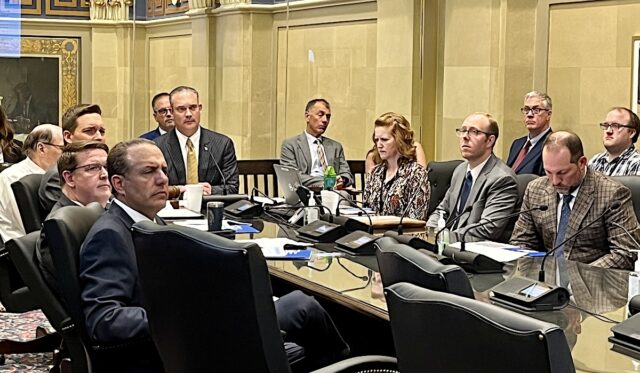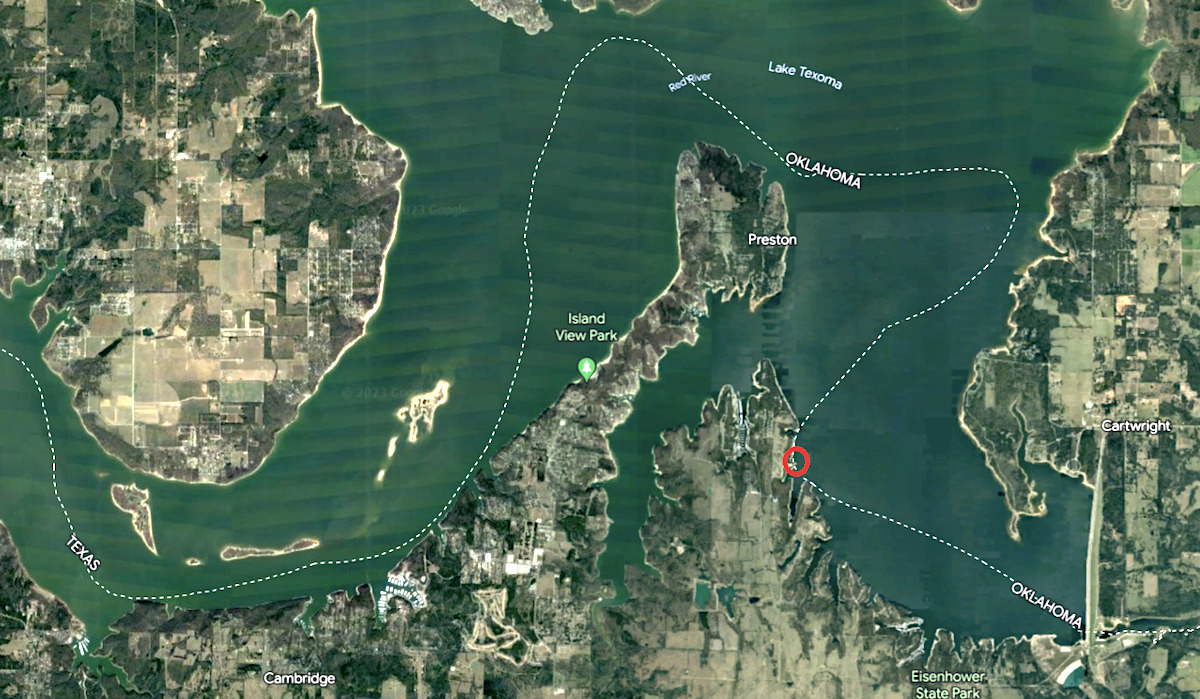

A reconstituted commission tasked with finding a solution to an unusual Red River boundary dispute over a North Texas Municipal Water District pump inadvertently located on the Oklahoma side of Lake Texoma met today, with state leaders saying they need to find a solution “in the best interest of Oklahomans.”
“Lake Texoma is a flood-control lake for the Red River to soften downstream impact of flooding, but the river runs through the lake, and that is the boundary that we are talking about,” House Speaker Charles McCall (R-Atoka) said after the meeting. “In this area where water is so important — it’s the No. 1 issue to people — (we must ensure) that the solution we come up with does not open the door for an argument for a taking of water by the state of Texas or any other state that has a current right to the waters of the Red River.”
To start that process, the Red River Boundary Commission — chaired by McCall — formally requested that the University of Oklahoma assemble a team of legal, engineering and other experts to put together a timeline for analyzing the property and water rights questions and reporting their findings back at a subsequent meeting.
“We could come up with an arbitrary valuation ourselves and make a counter proposal to their proposal,” McCall said. “But if we really are going to look at this objectively in terms of what the value should be and what the impact is and what the remedy should be, we need to have an independent Oklahoma interest look at this, bring that recommendation back and show us what the recommendation is. But ultimately it will be up to those who constitute this commission to accept or reject it.”
The bulk of Thursday’s meeting involved a presentation (embedded below) by representatives of the North Texas Municipal Water District regarding the history of the water pump and their proposed solution: adjusting the official Red River boundary and swapping about 1.34 acres of water surface area along a western shore of the lake’s southeast portion where the pump is located.
“[The pump] is operating. It is fully functioning, and it is operating under an MOU between the governors of Oklahoma and Texas that was signed in 2014,” said David Kelly, government affairs and special projects manager of the North Texas Municipal Water District. “[The MOU indicates] the state of Oklahoma’s acknowledgment of the issue and permission to continue the use of the pump station.”
Jenna Covington, executive director of the North Texas Municipal Water District, told the commission that the pump is authorized by the federal government to draw up to 196,000 acre-feet of water annually. She said its highest production thus far came in 2019 when about 123,000 acre-feet of water was pumped to support Texas communities, including the cities of Sherman and Dennison that are served by the Greater Texoma Utility Authority, which receives raw water from NTMWD.
“If we no longer had access to the Lake Texoma pump station, for the North Texas Municipal Water District, we would be losing over 20 percent of our water supply, and so there would be significant impacts to our communities,” Covington said. “The communities they serve — Sherman, Dennison and another almost 40 communities in that area — would not have access to reliable supplies.”
Covington and Kelly said constructing a new water pump in the Texas-controlled portion of Lake Texoma would cost at least $50 million and would take several years to complete.
“Not having access to reliable drinking water is a major impact to all communities, and it would put our communities at risk,” Covington said.
Senate Floor Leader Greg McCortney, who is serving on the commission as the Senate president pro tempore’s designee, said the state of Oklahoma does not want to eliminate water access for about 2 million people living in Texas. Like McCall, however, he said the situation presents questions about property and water rights that deserve attention.
“That’s the struggle. We have that friendly rivalry for sure, and we want to be good neighbors,” said McCortney (R-Ada). “At the same time when you kind of look at where we are, it’s hard to know what is the right path forward, and I think that’s why it took so long to get people into a room like this, and then our first action is to say, ‘Hey, we need people a whole lot smarter than me to help us figure out what we do next.'”
Reminded of the old adage — attributed both to Mark Twain and Will Rogers — that “Whiskey is for drinking and water is for fighting,” McCortney laughed.
“That’s a great quote for what we’re doing here,” McCortney said. “I think it affects every part of the state of Oklahoma when you start talking about water rights and water allocation. There’s really not a much more important conversation to have.”
‘Ensure nothing pierces the veil of interstate water sales’

Conversations about the problematic Lake Texoma water pump began in 2010 after the federal government alerted both states that the Texas water pump — constructed in 1989 — sat in Oklahoma waters following a 2000 redraw of the Red River boundary. In recent years, legislators have discussed the need to find a solution, but the only Oklahoma bill passed into law on the matter came in 2021 when legislators and the governor revived the Red River Boundary Commission with HB 2296.
“There’s been no formal meetings on it,” McCall said on prior legislative discussions. “We’ve just heard, ‘Oh, well, we think they’d be willing to give us this, would we take that?’ Well, we don’t know. We need to formally meet.”
McCall said that although OU’s research and Oklahoma’s commission may ultimately decide to ask Texas for a retroactive payment to cover past water usage, he said his priority is to protect Oklahoma’s legal stance against selling water out of state.
“This is a multi-faceted issue. The state of Oklahoma prohibits the sale of water out of state. That’s something that we are going to be very sensitive to,” McCall said. “We want to ensure nothing pierces the veil of interstate water sales.”
Some type of compensation could still be on the table, however, and McCall said Oklahoma needs to have more information and data at its disposal before considering Texas’ proposed no-cost land swap or any alternative proposal.
“There needs to be a formal methodology followed to arrive at what an adequate number is,” McCall said. “Is it $500,000? Or is it $500 million? Or some other number? We don’t know. But I think by following an approach and finding a methodology that is fair for Oklahoma, we provide a basis to Texas to say this is not an arbitrary number, here is what we are proposing, and you can accept it or you can turn it down.”
McCall said representatives of the Chickasaw Nation and Choctaw Nation were invited to Thursday’s meeting.
“We don’t believe that this land impacted is within any of the tribal nations’ land, but the Choctaw and the Chickasaw Nations are located within that area, they are Oklahomans just like all of us, and they would have interests just like all of us in the state,” McCall said.
Randy Sachs, director of public relations for the Choctaw Nation, told NonDoc that Choctaw leaders are keeping an eye on the matter and appreciate McCall’s effort to learn more information. A call to the Chickasaw Nation regarding Thursday’s meeting was not returned prior to the publication of this article.
McCortney said the entire situation interests him, particularly how one of the maps used in the 1980s to build the pump can no longer be found.
“This is, to me, absolutely fascinating. We’re literally talking about changing the borders of the state of Oklahoma. The nerd in me thinks this is a really, really fascinating thing to be a part of,” McCortney said. “The fact that all of this is largely based on the fact that they created the boundary between Oklahoma and Texas off of a certain map, and then they lost that map. I mean, that’s why we’re here.”
University of Oklahoma President Joe Harroz said OU is glad to help provide legal and other resources for the commission, and he attempted to end Thursday’s meeting with a moment of levity, albeit one that likely offered limited amusement to the commission’s North Texas Municipal Water District guests.
“To me, the only thing that is certain is that a solution would need to have some points added to next year’s OU-Texas game,” Harroz quipped.
Meanwhile, on the shores of Jefferson County
The Lake Texoma water pump problem is not the only Red River boundary dispute brewing between Oklahoma and Texas.
During the March meeting of Oklahoma’s Commissioners of the Land Office governing board, state leaders voted to join an anticipated lawsuit regarding ownership of property along the Red River in and around Jefferson County in southern Oklahoma.
Asked to clarify the case and CLO’s involvement, communications director David White provided a statement.
“The CLO owns a mineral interest in a parcel of land along the Red River in Jefferson County. Recently, a deed was filed by an adjoining landowner that potentially clouds title,” White said. “The surface owner intends to file a quiet title action in federal court. The surface owner is represented by the firm of MaHaffey Gore. The CLO has a preexisting contract with MaHaffey Gore and the firm has offered to represent the CLO in this matter at no cost. The surface owner will pay the legal fees. The litigation will ensure that the mineral interest of the CLO remains unencumbered by an onerous deed. If the CLO does not join as a plaintiff, the CLO will be named as a defendant. ”
Fights between Oklahomans and Texans over land in that area of the Red River are nothing new. In 1985, the Los Angeles Times chronicled a dispute over a similar area near the border in Jefferson County.
View the North Texas Municipal Water District presentation
https://nondoc.com/wp-content/uploads/2023/04/2023-04-13-Oklahoma-RRBC-Presentation-FINAL-1.pdf” viewer=”google”](Update: This article was updated at 1:30 p.m. Friday, April 14, to clarify information related to the North Texas Municipal Water District and correct reference to the year that HB 2296 was passed.)




















